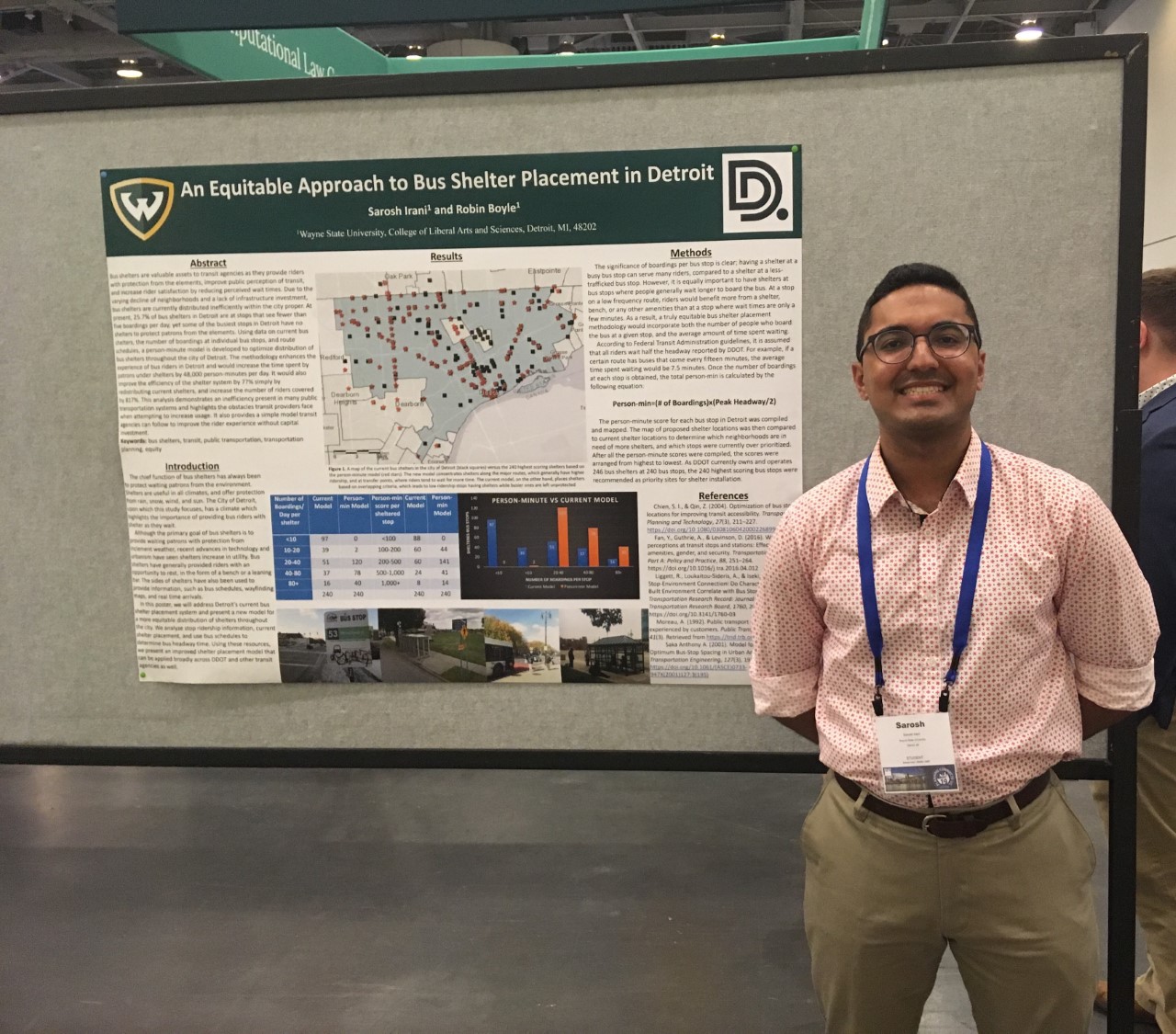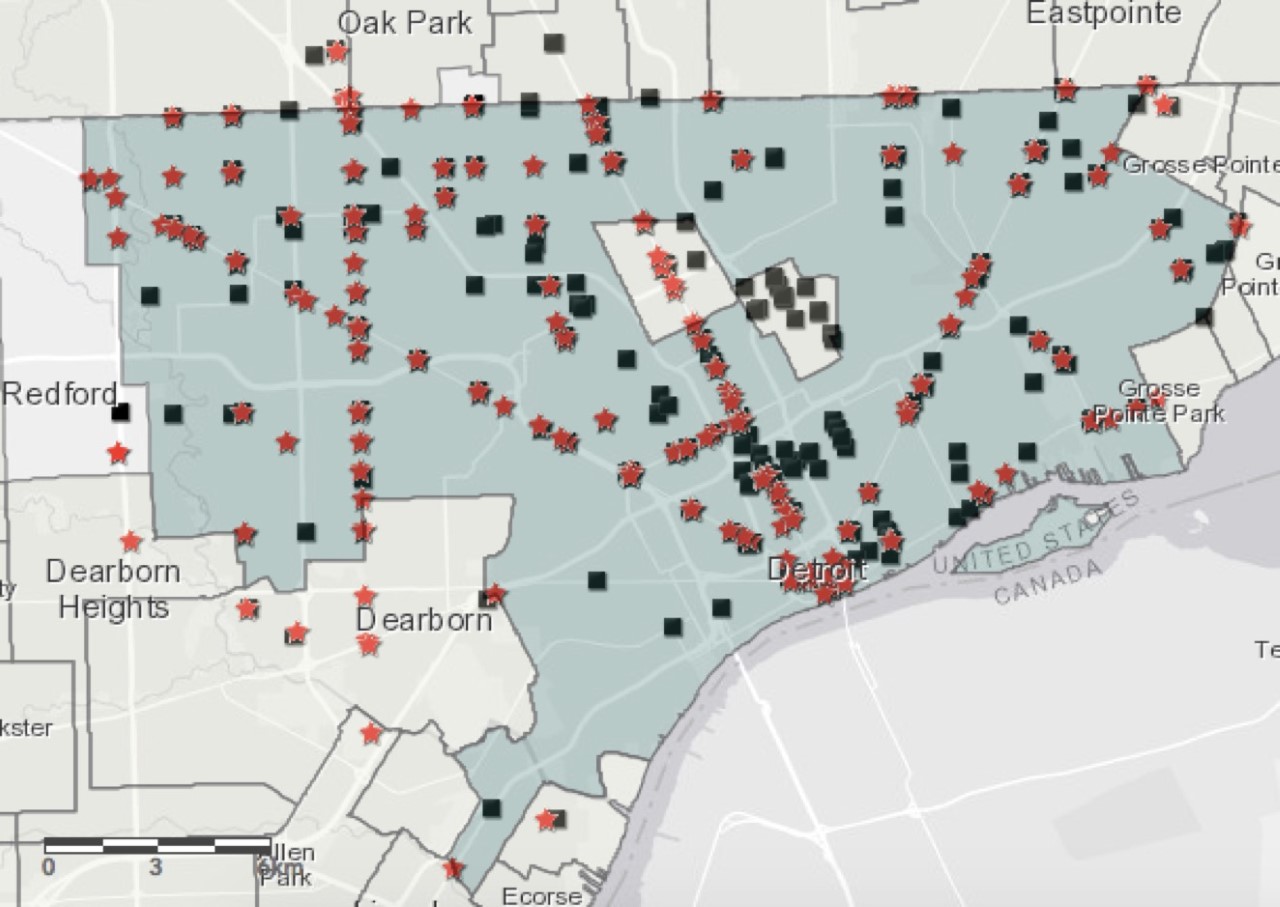Fixing an inefficiency: An honors student's research into bus shelter equality in Detroit

Planning Conference in San Francisco, CA.
Research inspiration can strike from anywhere.
Just ask Irvin D. Reid Honors College student and Public Health major Sarosh Irani, who found his inspiration on one of the most unlikely of sources - a Detroit city bus.
Irani, who frequently rides the bus since he doesn't own a car, noticed that his usual bus stop on the corner of Cass Ave. and Warren wasn't equipped with a bus shelter, even though there was usually a crowd of people waiting to get on the bus. He then noticed that a less frequented stop less than a mile down the road had a bus shelter. "It just seemed like an inefficiency in my eyes," he said.
He noticed the same thing at other stops in the city. "There is this extremely busy stop outside of the Rosa Parks Transit Center and all it has is a couple of benches. Later I found out that actually is the busiest stop in the City of Detroit, so if the busiest stop doesn't have a bus shelter, it shows you that there is an inefficiency that could be rectified."
So he went to work looking at ways to rectify the situation.
He worked with Department of Urban Studies and Planning Professor Robin Boyle, and together they developed a research proposal looking at how they could equitably redistribute bus shelters in the city of Detroit. Irani then submitted his proposal to UROP for grant funding, which he received.
After receiving permission from the Detroit Department of Transportation to use their database's information, Irani began comparing the locations of the bus stops in the city of Detroit that had shelters to the location of the busiest stops in the city. Discovering that 246 stops featured shelters, he developed a person-minute model where he multiplied the number of people who got on a bus at each stop each by the average person's wait time to determine each stop's value.
He tracked the number of daily riders over a 500 day period, beginning in January 2017, in order to account for an individual's riding habits changing due to weather. After compiling the data, his research reached two conclusions: only 1,600 people a day caught a bus from a stop with a shelter and 29% of the stops with shelters average less than five riders a day.
His proposal: re-allocate the shelters to the 246 busiest stops in the city.
"In our new model, just by moving the shelters around, not by adding more, we would see 14,000 people (have access to a bus shelter)," he said. "So it rose from 1,600 to 14,000, which is like an eight-hundred percent increase and it just highlights the inefficiencies really born out of the fact that Detroit's decline hasn't been consistent. There are different neighborhoods which has lost more people, different neighborhoods which have been more steady, and as a result the bus shelter system hasn't been modified to accommodate for that mostly because DDOT has so many other things that they are focusing on - making sure the buses run on time, reducing crime and so on and so forth."

with shelters. The Black squares represent current stops with
shelters, while the red stars represent proposed locations.
An additional benefit for DDOT is the organization could save money by repurposing and reallocating the bus shelters instead of buying new ones. According to Irani, the cost of relocating and repurposing a bus shelter is a significant savings compared to the cost of purchasing and installing a brand new one.
While being well-received by the planners at DDOT, Irani knew that implementation of his proposal could take some time.
"I know that they're (DDOT) working on adding more shelters in the future, but we think that just by moving the shelters we have right now, not even adding any more, we can make a really big impact and difference in the lives of Detroiters," Irani said.
He was able to present his research in April at the 2019 National Planning Conference of the American Planning Association in San Francisco, California. The American Planning Association is a professional organization representing the field of urban planning it the United States. It provides leadership in the development of vital communities for all by advocating excellence in planning, promoting education and resident empowerment, and providing members with the tools and support necessary to ethically meet the challenges of growth and change.
He was able to attend workshops on urban farming, streetscapes, bike lanes, pedestrian sidewalks in addition to many others relating to issues of urban planning during the four day conference.
"There was a lot of emphasis on health, a lot of emphasis on racial and social equality and my research kind of fell into the transportation subsection," he said. His research was presented alongside presentations on local bike shares, building better transit systems and parking.
Studying cities is nothing new for Irani. He has always been fascinated with cities, so coming to Wayne State and being able to explore the city through his coursework in the Honors College and in his daily routine "heightened" his interest even more. He S/Sconsidered becoming an urban planner before deciding to head into the public health realm.
"I realized that a lot of goals that urban planners have is to design communities to make them healthier, and that kind of aligns with public health," he continued. "I want to be a physician in the city, but also advocate for these things as well because I think they're really important to urban health."
While he is thrilled about the strides that have been made in public transportation around Wayne State, he hopes that it becomes a top priority at all governmental levels. He explained that for every tax dollar that is allocated for public transportation, the region sees at four dollar return on investment.
Even with the additions, Irani says there is still a need for improved service and frequency, especially in the suburbs, where whole communities can opt out of having bus service. "Because of that we have a piece mail system," he said. "Our bus will stop at the Novi border because it cannot operate in the city of Novi because they are not apart of the SMART system, and as a result, people will literally have to get off and then walk to their jobs."
"So…putting pressure on public officials to endorse public transit, because of the benefits it does provide, and helping them understand that even if they never ride the bus, and even if eighty percent of their constituents never ride the bus, it will still be an area of benefit for the whole," he continued.
He said that, ultimately, it boils down to the public wanting options for public transportation.
"I'm thrilled that we have more options and (that) more options are being presented, specifically in this area of Detroit. I think these initiatives kind of open the door for more things in the future because there are people who ride the QLine who would not get on a bus usually, who now know what the QLine is, they might say okay, I'm going to try the bus," he said.